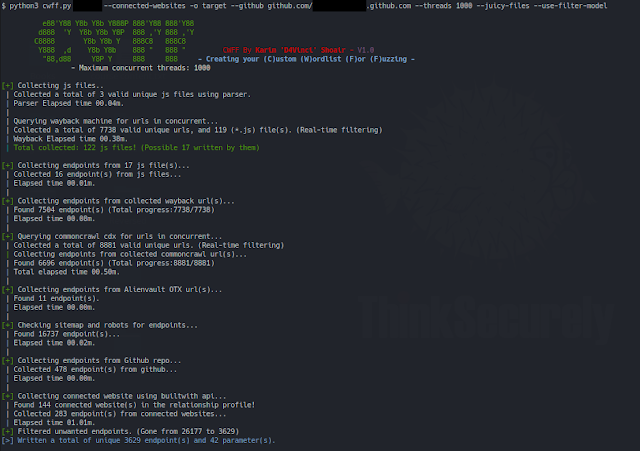CWFF is a tool that creates a special High quality fuzzing/content discovery wordlist for you at the highest speed possible using concurrency and it's heavily inspired by @tomnomnom's Who, What, Where, When, Wordlist #NahamCon2020.
Usage
Description (Important)
So it basically collects endpoints and parameters of the target and its subdomains using many sources we will talk about them now:
A lot of tools goes through the top page only of wayback to save time but here we go through all records at little time but this also makes it takes a lot of time when you use --subdomains flag.
Javascript files that's collected during the wayback phase and the ones collected by parsing the target page for <script> tagCWFF tries to separate the JS libraries from the JS files actually written by website developers and it does that by looking into JS files names. By default, CWFF extracts endpoints from the JS files written by developers only, to use JS libraries (Mostly not helpful) activate the --js-libraries flag.
Common crawl CDX index and Alien vault OTX (Open Threat Exchange) If you gave CWFF the --juicy-files flag, it would also extract endpoints from files like Sitemap.xml and robots.txt (Could add more in the future) If you gave CWFF a github repository using the --github flag, it would extract paths from that repo using Github API (No API key needed).Just to make it clear, CWFF would use the files and directories paths only so it won't extract endpoints from inside the files itself!
With using the --connected-websites flag, CWFF would use builtwith website API (Needs key but it's free) to extract the connected websites to the target from the relationship profile then extracts endpoints from these websites source. Note: you can get your API key from this page and set the variable at API_keys.py file.After collecting endpoints from all these endpoints if you used the --recursive flag, CWFF would recursively extract parts from collected endpoints.
Example: an endpoint like parseq/javadoc/1.1.0/com will become all these endpoints:Filtering results
Of course after all these sources and this work, there would be a lot of unwanted/useless endpoints among the important ones and here filtering comes to play to save time and resources.
In CWFF you can detect and remove the unwanted endpoints using three methods:
All this filter options can be given by setting the variables at filter_model.py file then use the --use-filter-model flag while starting CWFF. If you don't have an idea how to set this variables, see the comments I left in the file it's the one I mostly use and in the screenshot it lowered the number of collected endpoints from 26,177 to 3629. In case you forgot to use filtering while running CWFF, don't worry I got you covered
You can use script filter.py to filter endpoints you have as the following way and it would load the filter_model.py file automatically without having to rerun CWFF:
Requirements
Python 3.6+ It should work on any operating system but I only tested it on Linux Manjaro. The following instructionsInstallation
Contact
Twitter TelegramTODO
Merge endpoints recursively Extract website unique words by comparing to RFC.Disclaimer
CWFF is created to help in penetration testing and it's not responsible for any misuse or illegal purposes.
Copying a code from this tool or using it in another tool is accepted as you mention the source :smile
.png)
 4 years ago
268
4 years ago
268 
















 Bengali (Bangladesh) ·
Bengali (Bangladesh) ·  English (United States) ·
English (United States) ·